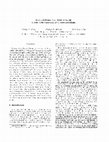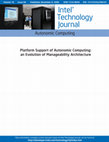Papers by Lenitra M Durham

Computers and education. Artificial intelligence, Jun 1, 2024
Educational technology research has found that parents of young children widely share concerns ab... more Educational technology research has found that parents of young children widely share concerns about extended screen time, lack of physical activity, and lack of social interaction. Kid Space was developed to address these concerns by enabling multi-modal and immersive collaborative play-based learning. Kid Space utilizes multiple sensing technologies with an immersive physical space through a human-scale wall projection and incorporates a conversational AI agent to interact with children, understand individual progress, and personalize learning experiences in a blended physical and digital environment. To evaluate Kid Space in the wild, we conducted a multi-method user study involving a quasi-experimental design and exploratory case study with 14 students and three educators in an elementary school. Mixed methods for data collection and analysis were used to understand the students' and educators' perceptions of Kid Space and its impact on the students' educational outcomes (learning engagement, experience, and performance). The findings showed (1) positive perceptions toward Kid Space, (2) high levels of engagement-with decreased screen time (41% of the time), increased physical activity (99.3% of the time), and increased social interactions with conversational AI agent and the other collaborating student (52% of the time), and (3) significant learning gains after experiencing Kid Space (24% gain, paired ttest: p < 0.01). These positive results are accompanied by critical user insights for improving future iterations of Kid Space to validate long-term educational outcomes.

Proceedings of SPIE, Jan 20, 2003
ABSTRACT Decentralized peer-to-peer (P2P) file sharing systems, where peers query each other for ... more ABSTRACT Decentralized peer-to-peer (P2P) file sharing systems, where peers query each other for content, are the most dominant in today&#39;s Internet. In the unstructured decentralized P2P systems, there is no direct connection between content location and system topology. Searches in such systems are typically broadcast within a limited region of the network and thus may not receive a response if the content is not within that region. Structured decentralized P2P systems provide a connection between content location and the system topology. There, queries can be directed to a peer who can respond definitively. Research in distributed computing has examined the problem of matching a client process to a desired server process. An approach to solving this distributed match-making problem is to have the server &quot;post&quot; or replicate information to other nodes in the system. We modify this approach to be used in the decentralized P2P file sharing environment. In this paper we propose a &quot;posting&quot; protocol to improve the success of searches in the decentralized P2P systems. By having peers replicate keyword information to other peers the search success rate can be increased. We evaluate different posting policies and compare the results for searching with and without posting.
International Conference on Internet Computing, 2002

In Internet multicast, the set of receivers can be dynamic with receivers joining and leaving a g... more In Internet multicast, the set of receivers can be dynamic with receivers joining and leaving a group asynchronously and without the knowledge of the sources. The Internet today uses source-based s c oping by which the source determines how far its multicast transmissions will propagate. This mechanism, however, does not allow a receiver to bound the number of hops added to a multicast routing tree a s a r esult of its join request or its continued membership. In this paper we explore the use of receiver-based s c oping, in which a receiver's join request is augmented with one or more s c ope values. By use of these values, the receiver speci es its wish to join and remain in the multicast group as long as the number of additional hops its membership incurs is within its declared s c ope. In environments where a multicast receiver incurs a cost in relation to its incremental resource usage, this scoping technique can be used to give the receiver direct control over this cost. The paper is concerned with discussion of the design of the receiver-based s c oping mechanism and its possible use within multicast applications. We also consider the implementation of the mechanism as an extension to the existing Internet multicast infrastructure in a manner that is independent of the multicast routing protocol in use.
Proceedings Sixth International Conference on Network Protocols (Cat. No.98TB100256)
Proceedings Eight International Conference on Computer Communications and Networks (Cat. No.99EX370)

Multimedia Computing and Networking 2003, 2003
ABSTRACT Decentralized peer-to-peer (P2P) file sharing systems, where peers query each other for ... more ABSTRACT Decentralized peer-to-peer (P2P) file sharing systems, where peers query each other for content, are the most dominant in today&#39;s Internet. In the unstructured decentralized P2P systems, there is no direct connection between content location and system topology. Searches in such systems are typically broadcast within a limited region of the network and thus may not receive a response if the content is not within that region. Structured decentralized P2P systems provide a connection between content location and the system topology. There, queries can be directed to a peer who can respond definitively. Research in distributed computing has examined the problem of matching a client process to a desired server process. An approach to solving this distributed match-making problem is to have the server &quot;post&quot; or replicate information to other nodes in the system. We modify this approach to be used in the decentralized P2P file sharing environment. In this paper we propose a &quot;posting&quot; protocol to improve the success of searches in the decentralized P2P systems. By having peers replicate keyword information to other peers the search success rate can be increased. We evaluate different posting policies and compare the results for searching with and without posting.

Intel Technology Journal, Nov 9, 2006
Autonomic Computing (AC) is maturing from a design philosophy to an emerging set of technologies ... more Autonomic Computing (AC) is maturing from a design philosophy to an emerging set of technologies and products that addresses the complexity of managing today's heterogeneous data centers and computing environments. This overview paper explains our motivation and outlines our technologies that provide platform support for AC. Specifically, we are developing platforms with sufficient support and on-board intelligence to enable autonomic capabilities, such as selfhealing and self-protecting, as well as features such as discovery and asset tracking, even when the host Operating System (OS) is inactive. To achieve these ends we are dedicating select platform resources and firmware, both exposed via well-defined standard interfaces, to implement a set of management and autonomic capabilities, and in the future, we hope to extend these platform autonomic capabilities, with appropriate management policies, to groups of platforms and eventually to the entire data center. Such interconnected autonomic platforms will provide the infrastructure and fabric to support service-oriented, grid, and utility computing. This paper also expounds on the Intel ® Active Management Technology † (Intel AMT) which is the first product incarnation of a framework and dedicated platform execution environment for AC. We also discuss how manageability architectures need to evolve to support autonomic behavior at a group level, such as defining interactions among platforms within a group to collectively deliver on specific goals and implement group-level policies. We cite examples related to malware detection and power management that illustrate how this new approach to managing IT infrastructure works. INFORMATION TECHNOLOGY OVERVIEW Today, Information Technology (IT) departments are plagued by increasing complexity, poor utilization of assets, space, and high power consumption. Further, system management in such environments is fragmented and labor-intensive requiring considerable human involvement for mundane functions such as configuration and provisioning. Such common inefficiencies in data centers force IT managers to provision their data centers for peak loads resulting in low average resource utilization and availability in the range of 99.99% or possibly less. Current data center deployments tend to have strong and static binding between servers and applications, as well as between servers and administrators, due mainly to a lack of technology to deploy otherwise. To improve the efficiency of assets, space, and power, IT managers turned to virtualization, which provides the ability to consolidate multiple applications onto a single server (a server could be stand-alone, rack-mounted or bladed). These servers may include advanced technologies that support multiple logical and physical partitions within each physical machine such as virtualization, partitioning hooks, and multiple cores. These advanced technologies have increased the cost and complexity of platforms and require that management solutions adapt to deal with them. Unfortunately, management solutions have not kept pace.
CRC Press eBooks, Dec 15, 2006

Kid Space is a smart space for children, enabled by an innovative, centralized projection device ... more Kid Space is a smart space for children, enabled by an innovative, centralized projection device that senses multimodal interactivity and intelligently projects augmented reality (AR) content across surfaces. Kid Space uses a visible agent to guide learning through play. Two preliminary studies evaluated Kid Space with children 5 to 8 years old. Study 1 showed that children engaged enthusiastically with the projected character during a math exercise and during physically active games. A parent questionnaire showed that parents valued Kid Space for learning and physical activity. Study 2 found that children engaged with a projected agent at a closer distance than with a television. Parents showed a preference for a projected AR agent over an agent on a television or a standard projection. Parents also showed a preference for an agent that demonstrated awareness of children's physicality in the space.
Personal informatics has become a widespread practice, yet even expert users still face challenge... more Personal informatics has become a widespread practice, yet even expert users still face challenges in synthesizing and making sense of data. We suggest that these challenges are related to the complexities introduced once personal context is taken seriously. Through ethnographic research in the Quantified Self community, and an iterative software design process for a project called Data Sense, we offer early indications of what those challenges are, and describe how we approached solving them. We found that users had an easier time of working with data when they could use their own files, when temporal recurrences were surfaced and reminded them of other patterns, and when they could "grab" data directly from visualizations. However, the system did require more user learning than we anticipated.
self-managed infrastructure, utility computing Autonomic Computing (AC) is maturing from a design... more self-managed infrastructure, utility computing Autonomic Computing (AC) is maturing from a design philosophy to an emerging set of technologies and products that addresses the complexity of managing today’s heterogeneous data centers and computing environments. This overview paper explains our motivation and outlines our technologies that provide platform support for AC. Specifically, we are developing platforms with sufficient support and on-board intelligence to enable autonomic capabilities, such as selfhealing and self-protecting, as well as features such as discovery and asset tracking, even when the host Operating System (OS) is inactive. To achieve these ends we are dedicating select platform resources and firmware,

Educational Technology Research and Development, 2022
Parents recognize the potential benefits of technology for their young children but are wary of t... more Parents recognize the potential benefits of technology for their young children but are wary of too much screen time and its potential deficits in terms of social engagement and physical activity. To address these concerns, related literature suggests technology usages with a blend of digital and physical learning experiences. Towards this end, we developed Kid Space, incorporating immersive computing experiences designed to engage children more actively in physical movement and social collaboration during play-based learning. The technology features an animated peer learner, Oscar, who aims to understand and respond to children's actions and utterances using extensive multimodal sensing and sensemaking technologies. To investigate student engagement during Kid Space learning experiences, an exploratory case study was designed using a formative research method with eight firstgrade students. Multimodal data (audio and video) along with observational, interview, and questionnaire data were collected and analyzed. The results show that the students demonstrated high levels of engagement, less attention focused on the screen (projected wall), and more physical activity. In addition to these promising results, the study also enabled us to understand actionable insights to improve Kid Space for future deployments (e.g., the need for real-time personalization). We plan to incorporate the lessons learned from this preliminary study and deploy Kid Space with real-time personalization features for longer periods with more students.

Proceedings of the Group Interaction Frontiers in Technology, 2018
Kid Space is a smart space for children, enabled by an innovative, centralized projection device ... more Kid Space is a smart space for children, enabled by an innovative, centralized projection device that senses multimodal interactivity and intelligently projects augmented reality (AR) content across surfaces. Kid Space uses a visible agent to guide learning through play. Two preliminary studies evaluated Kid Space with children 5 to 8 years old. Study 1 showed that children engaged enthusiastically with the projected character during a math exercise and during physically active games. A parent questionnaire showed that parents valued Kid Space for learning and physical activity. Study 2 found that children engaged with a projected agent at a closer distance than with a television. Parents showed a preference for a projected AR agent over an agent on a television or a standard projection. Parents also showed a preference for an agent that demonstrated awareness of children's physicality in the space.











Uploads
Papers by Lenitra M Durham